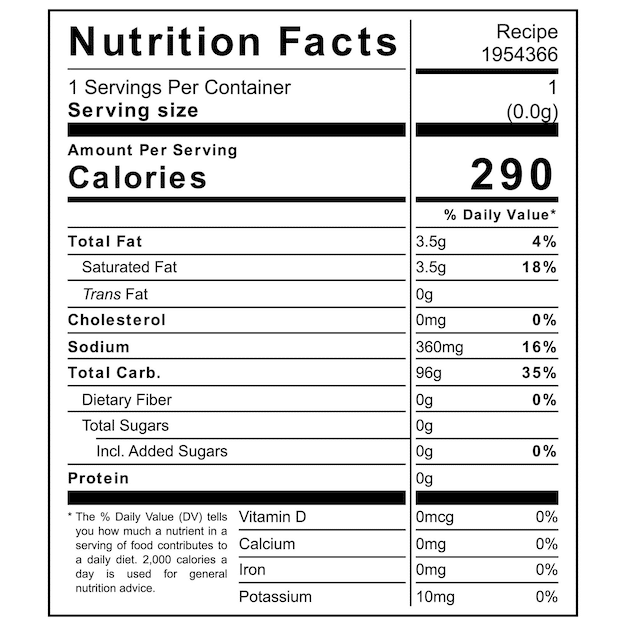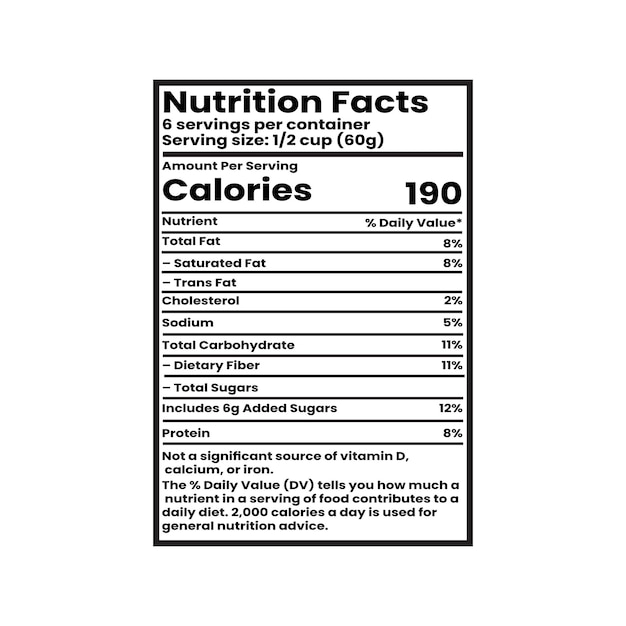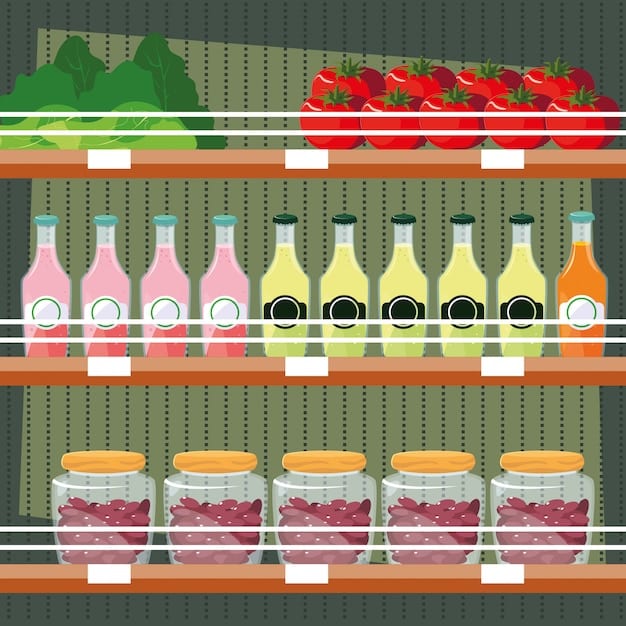Updated Food Labeling Requirements: Added Sugars Guide

Updated food labeling requirements regarding added sugars aim to provide consumers with clearer nutritional information, helping them make informed choices about their sugar intake.
Navigating the grocery store aisles just got a little easier. With the updated food labeling requirements, understanding the amount of added sugars in your favorite foods is now more straightforward, empowering you to make healthier dietary choices.
The Evolution of Food Labeling
Food labels have come a long way. Initially, they provided basic information, but as nutritional science advanced, so did the requirements for what must be included. Understanding this evolution helps appreciate the significance of the updated food labeling requirements.
The push for more transparent labeling arose from increasing concerns about public health issues linked to excessive sugar consumption. Here’s a look at some milestones:
Early Regulations
Early food labeling regulations focused primarily on identifying the product and listing basic ingredients. There was little emphasis on nutritional content, making it difficult for consumers to make informed choices.
The Nutrition Labeling and Education Act (NLEA)
The NLEA of 1990 was a game-changer. It mandated that most food products include a standardized nutrition facts panel. This included information on calories, total fat, cholesterol, sodium, total carbohydrates, protein, and certain vitamins and minerals.
- Transparency: The NLEA significantly increased the transparency of food products, providing consumers with a standardized way to assess nutritional content.
- Health Claims: It also regulated health claims on food labels, ensuring that claims were scientifically valid and not misleading.
- Serving Sizes: Standardized serving sizes were introduced to make it easier to compare similar products.
The Latest Updates
In recent years, the Food and Drug Administration (FDA) has implemented updates to the nutrition facts label, with a significant focus on added sugars. These changes aim to reflect new scientific information, including the link between added sugars and chronic diseases.

The evolution of food labeling reflects a growing awareness of the importance of nutritional information. The updated food labeling requirements build upon previous regulations, providing consumers with even more detailed and accurate information to make informed dietary choices.
Decoding the New “Added Sugars” Label
One of the most significant changes in the updated food labeling requirements is the specific inclusion of “Added Sugars” on the nutrition facts label. This provides clarity that was previously lacking, making it easier for consumers to understand where sugars in their food come from.
But what exactly are added sugars, and why is this information so important?
What Are Added Sugars?
Added sugars are sugars and syrups that are added to foods or beverages during processing or preparation. They are distinct from naturally occurring sugars, such as those found in fruits and milk.
Common examples of added sugars include:
- Table sugar (sucrose)
- High-fructose corn syrup
- Honey
- Maple syrup
- Agave nectar
Why the Focus on Added Sugars?
The focus on added sugars stems from research linking excessive consumption to several health problems, including:
- Weight gain and obesity
- Type 2 diabetes
- Heart disease
- Tooth decay
By clearly labeling added sugars, consumers can better track their intake and make choices that align with dietary guidelines.
How to Interpret the Label
The “Added Sugars” line on the nutrition facts label appears directly below “Total Sugars.” It indicates the amount of sugar that has been added to the product during processing.
For example, a yogurt might have 15 grams of total sugars, with 5 grams coming from added sugars. This means that 10 grams of sugar are naturally present in the yogurt, likely from lactose. You can distinguish what you want to consume and what you want to dismiss from a product.
Understanding the “Added Sugars” label is crucial for making informed decisions about your sugar intake. With this information, consumers can better manage their diets and reduce their risk of sugar-related health issues. These updated food labeling requirements will allow you to get the right information.
The Impact on Food Manufacturers
The updated food labeling requirements have not only impacted consumers but also food manufacturers. These companies have had to reformulate products, update labels, and ensure compliance with the new regulations.
Here’s a look at some of the ways these changes have affected the food industry:
Reformulation of Products
Many food manufacturers have responded to the new labeling requirements by reformulating their products to reduce the amount of added sugars. This can involve replacing added sugars with alternative sweeteners or adjusting recipes to minimize sugar content without sacrificing taste.
Label Updates
Updating labels to include the “Added Sugars” line requires significant effort. Manufacturers must analyze the sugar content of their products, determine the amount of added sugars, and redesign their labels to comply with the new format.
This process can be time-consuming and costly, particularly for smaller companies with limited resources.
Marketing Strategies
The focus on added sugars has also influenced marketing strategies. Some companies are highlighting products with lower added sugar content or promoting “no added sugar” versions to appeal to health-conscious consumers.
This has led to increased competition in the market, with companies vying to offer healthier options.

The updated food labeling requirements have prompted significant changes within the food industry. While these changes present challenges, they also offer opportunities for innovation and the development of healthier food products. These changes have helped consumers differentiate healthy and unhealthy options.
Navigating Common Misconceptions
With any new regulation, misconceptions are bound to arise. Let’s address some common misunderstandings about the updated food labeling requirements related to added sugars.
“Total Sugars” vs. “Added Sugars”
One of the most common confusions is the difference between “Total Sugars” and “Added Sugars.” While “Total Sugars” includes all sugars present in the food, “Added Sugars” specifically refers to sugars added during processing.
Understanding this distinction is crucial for accurately assessing the sugar content of a product.
“Sugar-Free” Doesn’t Always Mean Healthy
Just because a product is labeled “sugar-free” doesn’t automatically make it healthy. Some sugar-free products may contain artificial sweeteners or other additives that can have negative health effects.
Always read the ingredient list and consider the overall nutritional profile of the product.
Natural Sugars Are Always Better
While natural sugars found in fruits and vegetables are often viewed as healthier, they still contribute to overall sugar intake. It’s important to consume these foods in moderation as part of a balanced diet.
The key is to focus on whole, unprocessed foods that naturally contain sugars, rather than relying on processed foods with added sugars.
By dispelling these common misconceptions, consumers can make more informed decisions about their sugar intake and overall diet. In the end, understanding the updated food labeling requirements benefits everyone.
Tips for Reducing Added Sugar Intake
Now that you understand the updated food labeling requirements, what steps can you take to reduce your intake of added sugars?
Here are some actionable tips to help you manage your sugar consumption:
Read Labels Carefully
Make it a habit to read nutrition facts labels and ingredient lists before purchasing food products. Pay close attention to the “Added Sugars” line and the ingredients list, looking for common added sugars like high-fructose corn syrup, sucrose, and dextrose.
Choose Whole, Unprocessed Foods
Focus on incorporating more whole, unprocessed foods into your diet. These foods naturally contain fewer added sugars and are packed with essential nutrients, vitamins, and minerals.
Examples include fresh fruits, vegetables, lean proteins, and whole grains.
Cook at Home More Often
Cooking at home gives you control over the ingredients you use, allowing you to limit or eliminate added sugars. Experiment with different recipes and find ways to sweeten dishes naturally, such as with fruit or spices.
- Limit sugary drinks: Avoid sodas, juices, and sweetened beverages. Choose water, unsweetened tea, or sparkling water instead.
- Beware of sneaky sugars: Added sugars can hide in unexpected places, like sauces, dressings, and processed snacks. Always read labels carefully.
- Opt for natural sweeteners: If you need to sweeten something, consider using natural sweeteners like stevia or monk fruit in moderation.
By implementing these tips, you can effectively reduce your intake of added sugars and improve your overall health. The updated food labeling requirements are there to guide you!
The Future of Food Labeling
The updated food labeling requirements are a significant step forward, but the evolution of food labeling is far from over. As scientific understanding of nutrition advances, we can expect further changes and improvements to food labels.
Here are some potential future developments:
Greater Transparency
Consumers are increasingly demanding greater transparency from food manufacturers. This could lead to more detailed information on labels, such as the source of ingredients, the presence of allergens, and the environmental impact of food production.
Technological Innovations
Technological innovations, such as QR codes and smartphone apps, could provide consumers with access to even more detailed information about the foods they eat. These tools could offer personalized nutritional recommendations and help consumers make healthier choices.
Standardized Front-of-Package Labeling
Some countries have implemented standardized front-of-package labeling systems, such as Nutri-Score, which provide a simple, at-a-glance assessment of the nutritional quality of a product. This could become more widespread in the future.
- Focus on ultra-processed foods: Future labeling efforts may focus on identifying and highlighting ultra-processed foods, which are often high in added sugars, unhealthy fats, and artificial additives.
- Personalized nutrition: Advances in genetics and data science could lead to personalized nutrition recommendations based on individual health needs and preferences.
- Sustainability labeling: As environmental concerns grow, food labels may start to include information on the carbon footprint, water usage, and other environmental impacts of food production.
The future of food labeling is likely to be driven by a combination of scientific advancements, consumer demand, and regulatory changes. The goal is to provide consumers with the information they need to make informed choices and promote healthier eating habits. The updated food labeling requirements are a good baseline to evolve from.
| Key Point | Brief Description |
|---|---|
| 📝 Added Sugars Label | Indicates sugars added during processing, distinct from natural sugars. |
| 🍎 Whole Foods | Prioritize whole, unprocessed foods to minimize added sugar intake. |
| 💡 Read Labels | Always check nutrition labels for “Added Sugars” and ingredient lists. |
| 🥤 Sugary Drinks | Limit sugary drinks to reduce overall sugar intake. |
FAQ
▼
Added sugars are sugars and syrups added to foods during processing. They differ from naturally occurring sugars in fruits and milk. Examples include table sugar, high-fructose corn syrup, and honey.
▼
Excessive consumption of added sugars is linked to various health issues, including weight gain, type 2 diabetes, heart disease, and tooth decay. Limiting intake can improve overall health.
▼
Look for the “Added Sugars” line on the nutrition facts label, located directly below “Total Sugars.” Also, check the ingredient list for common added sugars listed by different names.
▼
While natural sugars in whole foods are preferable, they still impact overall sugar intake. Focus on moderation and choosing whole, unprocessed foods over those with added sugars.
▼
Read labels carefully, choose whole foods, cook at home more often, limit sugary drinks, and be aware of sneaky sugars in processed snacks and condiments to reduce your daily intake.
Conclusion
Understanding the updated food labeling requirements regarding added sugars empowers consumers to make informed choices and prioritize their health. By reading labels carefully, choosing whole foods, and being mindful of added sugar intake, you can take control of your diet and reduce your risk of sugar-related health issues.





